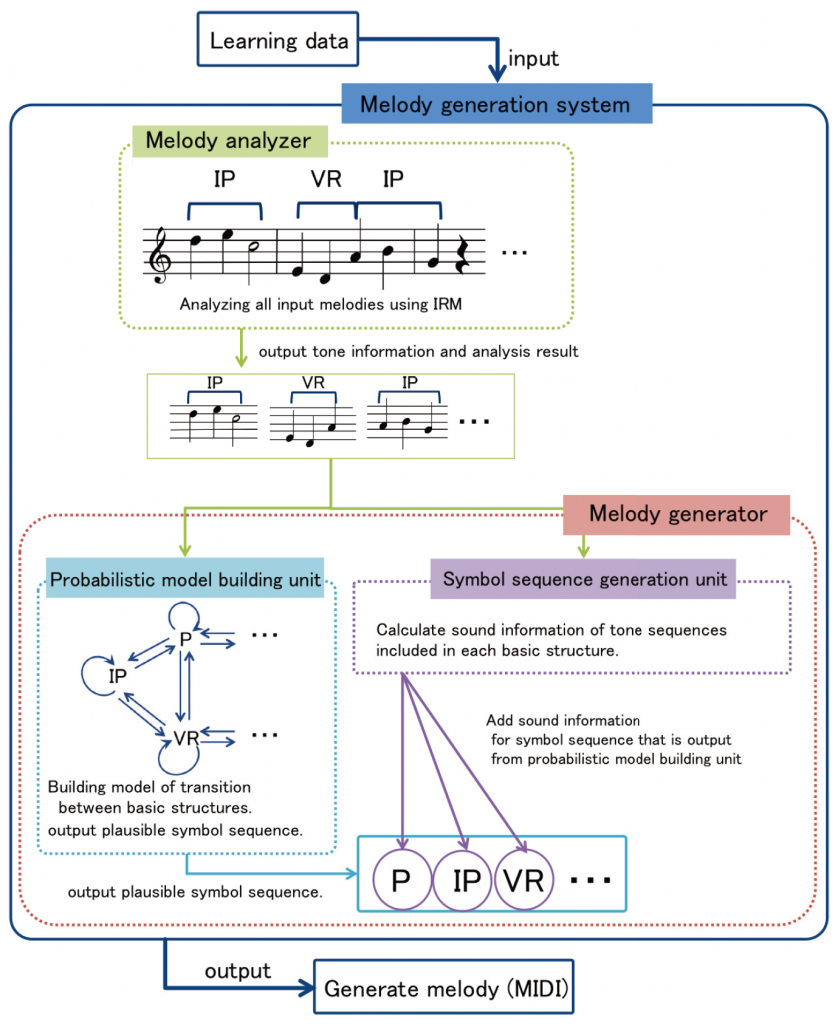We propose a melody generation system based on the Implication-Realization Model (IRM) of music theory. The IRM is a music theory, which was proposed by Eugene Narmour. The IRM abstracts music. It then expresses music according to symbol sequences based on information constituting the music pitch, rhythm, and rests. Previous melody generation systems are mostly based on tone transition models, which do not have function of abstracting melodies observed in training data. In those previous systems, generated melodies do not reflect tone sequences that do not exist in training data. However, it is obviously required that a melody generation system is able to abstract melodies in training data and to output certain melody, which is rarely observed in the training data. Our melody generation approach properly abstracts melodies in training data based on the IRM. The IRM expresses contexts of melodies using symbol sequences. Our melody generation system consists of two models; that of symbol sequence transition and that of generating tones from symbols. With the former model, the symbol transition probability model is trained with the results of the IRM analysis. The system then generates an optimal symbol sequence according to the probability model. Then, from a set of tones, each symbol sequence generates a melody. We evaluated the proposed system through subjective human judgment and the results showed that our system properly generated melodies.

▲ Processing flow of proposed melody generation system

▲An Example of Analysing Melodies according to IRM
References
- [Music Analysis] Sakurako Yazawa, Masatoshi Hamanaka: “Extension of Implication-Realization Model for Subjective Melodic Similarity”, BKN25 Milestones in Music Cognition, July 2014.
- [PDF] [Music Analysis] Sakurako Yazawa, Masatoshi Hamanaka, Takehito Utsuro: “Melody Generation System based on a Theory of Melody Sequences”, International Conference on advanced Informatics: Concepts, Theory and Applications, pp347-352, August 2014.
- [PDF] [Music Analysis] Sakurako Yazawa, Masatoshi Hamanaka: “Melody Generation system based on Music Theory”, JSAI2014 The 28th Annual Conference of the Japanese Society for Artificial Intelligence, 4G1-5, May 2014.
- [LINK] [Music Analysis] Sakurako Yazawa, Masatoshi Hamanaka: “Extension Implication-Realization Model for Subjectivity Melodic Similarity ”, IPSJ Special Interest Group on Music and Computer, 2014-MUS-102, No.1, 5 pages, Feb 2014.
- [PDF] [Music Analysis] Sakurako Yazawa, Yuhei Hasegawa, Kouhei Kanamori, Masatoshi Hamanaka : “MIREX 2013 SYMBOLIC MELODIC SIMILARITY: Melodic Similarity based on Extension Implication-Realization Model “, MIREX 2013 Symbolic Melodic Similarity Results, 2013.
- [PDF] [Music Analysis] Sakurako Yazawa, Hiroko Terasawa, Keiji Hirata, Satoshi Tojo, Masatoshi Hamanaka: “Analysis the chain structures of Implication-Realization Model in a melody”,IPSJ Special Interest Group on Music and Computer,2012-MUS94SLP90, No.34, February 2012.
- [PDF] [Music Analysis] Sakurako Yazawa, Hiroko Terasawa, Keiji Hirata, Satoshi Tojo, Masatoshi Hamanaka: “Identifying the basic structures of Implication-Realization Model in a melody”, IPSJ Special Interest Group on Music and Computer , 2010-MUS-87, No.1 ,Oct 2010.